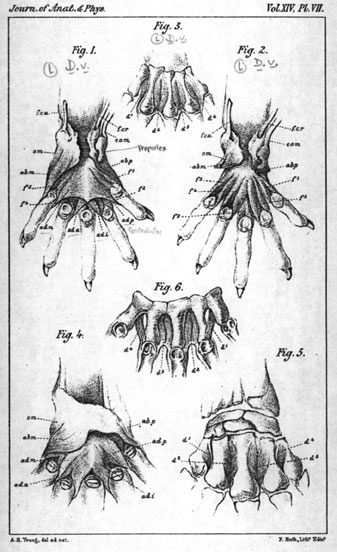Dissection and Drawing Workshop with Real Anatomical Specimens

"Opossum forepaw anatomy," from a paper in the Journal of Anatomy and Physiology, 1879 called "The Intrinsic Muscles of the Marsupial Hand"
Dissection and drawing class with physical anthropologist Samuel Strong Dunlap, PhD
Date: Saturday, March 17
Time: 10:00 AM - 4:30 PM
Admission: $60
*** SOLD OUT; please email morbidanatomy [at] gmail.com to be added to wait list
This class is part of the Morbid Anatomy Art Academy
Modern scientific dissection and illustrations commenced in the Renaissance. Basic anatomical dissection, illustration and knowledge are still fundamental in many fields such as evolutionary biology, surgery, quality medical schools, and forensic science.
In today’s workshop, we will dissect and draw a Didelphis virginiana-the North American opossum-a “living fossil” whose anatomy has remained virtually unchanged over the past 70 million years; this creature is considered to be a good model for a basal-i.e. early or original-mammal. Many comparative skeletal materials will be available for examination and illustration, and additional specimens may also be available. Gloves, scalpels and probes will be provided. Marie Dauenheimer, medical illustrator (and instructor of tomorrow’s carbon dust workshop), will assist with this workshop.
Materials to bring with you to class:
- Good quality drawing paper
- Graphite pencils, HB, 2B
- Colored pencils, emphasis on blue and brown shades
- Erasers
Dr. Samuel Strong Dunlap is a physical anthropologist teaching and conducting research in the Washington, DC metropolitan area. He specializes in human and primate musculoskeletal anatomy with the goal of clarifying evolutionary and development issues. Since completion of his PhD at Michigan State University he has worked and done research in forensic anthropology, human and primate anatomy and human evolution. He has worked on human burial sites, forensic cases, with museum collections at Case Western Reserve University, the Smithsonian and Howard University Anatomy department. Archeology field experience included: an 18th century French fort in Indiana, a Mousterian site in Tuscany and a 100 square mile religious area in the Siskiyou Mountains of northern California. He recently gave a lecture at Observatory about his relative Charles Wilson Peale.